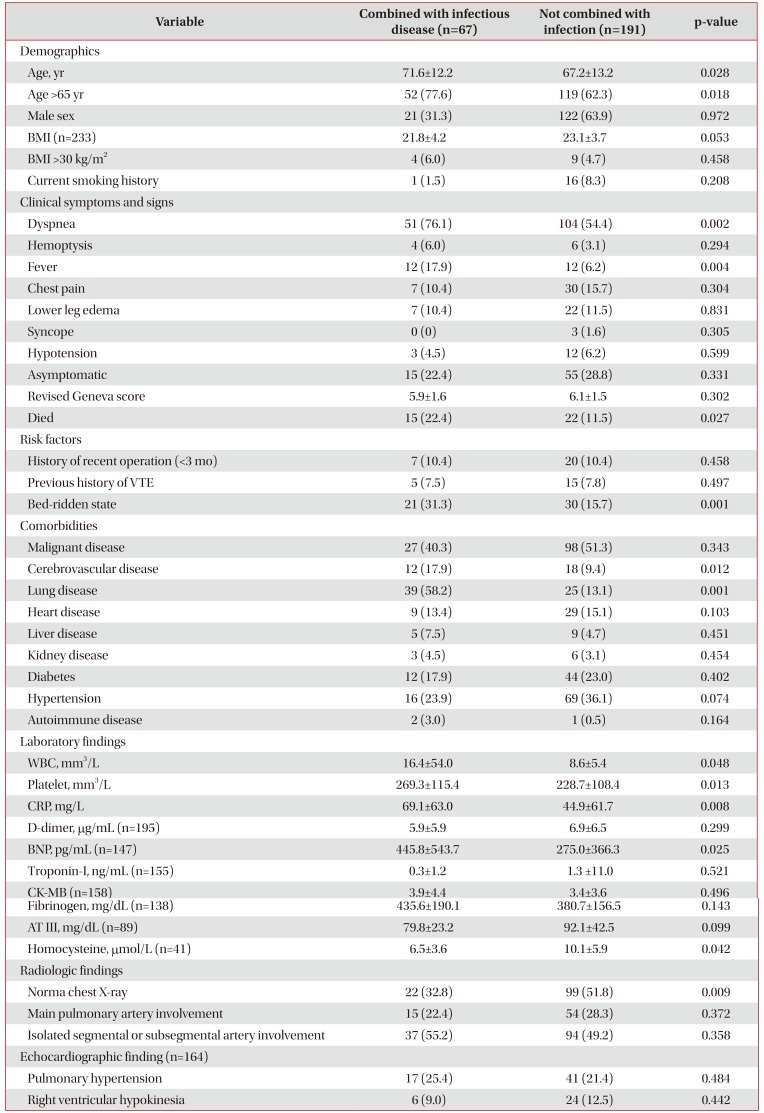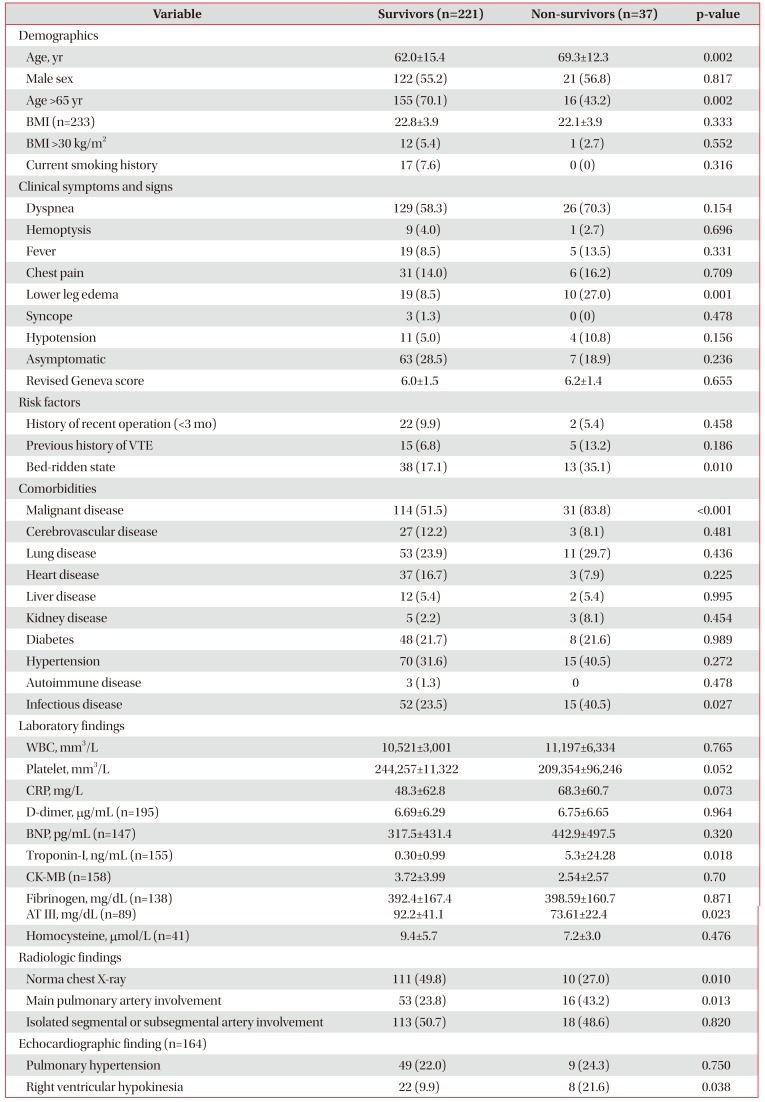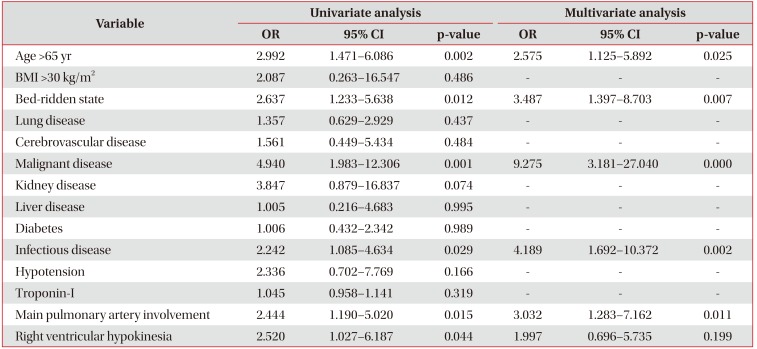1. Goldhaber SZ. Pulmonary embolism. Lancet. 2004; 363:1295–1305. PMID:
15094276.

2. Heit JA. Epidemiology of venous thromboembolism. Nat Rev Cardiol. 2015; 12:464–474. PMID:
26076949.

3. Hong J, Lee JH, Yhim HY, Choi WI, Bang SM, Lee H, et al. Incidence of venous thromboembolism in Korea from 2009 to 2013. PLoS One. 2018; 13:e0191897. PMID:
29370290.

4. Jang MJ, Bang SM, Oh D. Incidence of venous thromboembolism in Korea: from the Health Insurance Review and Assessment Service database. J Thromb Haemost. 2011; 9:85–91. PMID:
20942850.

5. Anderson FA Jr, Spencer FA. Risk factors for venous thromboembolism. Circulation. 2003; 107(23 Suppl 1):I9–I16. PMID:
12814980.

6. Heit JA. Risk factors for venous thromboembolism. Clin Chest Med. 2003; 24:1–12. PMID:
12685052.

7. Smeeth L, Cook C, Thomas S, Hall AJ, Hubbard R, Vallance P. Risk of deep vein thrombosis and pulmonary embolism after acute infection in a community setting. Lancet. 2006; 367:1075–1079. PMID:
16581406.

8. Grainge MJ, West J, Card TR. Venous thromboembolism during active disease and remission in inflammatory bowel disease: a cohort study. Lancet. 2010; 375:657–663. PMID:
20149425.

9. Cervantes J, Rojas G. Virchow's Legacy: deep vein thrombosis and pulmonary embolism. World J Surg. 2005; 29 Suppl 1:S30–S34. PMID:
15818472.

10. Bhagat K, Moss R, Collier J, Vallance P. Endothelial “stunning” following a brief exposure to endotoxin: a mechanism to link infection and infarction? Cardiovasc Res. 1996; 32:822–829. PMID:
8944812.

11. Copur AS, Smith PR, Gomez V, Bergman M, Homel P. HIV infection is a risk factor for venous thromboembolism. AIDS Patient Care STDS. 2002; 16:205–209. PMID:
12055028.

12. Wijarnpreecha K, Thongprayoon C, Panjawatanan P, Ungprasert P. Hepatitis C virus infection and risk of venous thromboembolism: a systematic review and meta-analysis. Ann Hepatol. 2017; 16:514–520. PMID:
28611268.

13. Schimanski S, Linnemann B, Luxembourg B, Seifried E, Jilg W, Lindhoff-Last E, et al. Cytomegalovirus infection is associated with venous thromboembolism of immunocompetent adults: a case-control study. Ann Hematol. 2012; 91:597–604. PMID:
21913128.
14. Paran Y, Halutz O, Swartzon M, Schein Y, Yeshurun D, Justo D. Venous thromboembolism and cytomegalovirus infection in immunocompetent adults. Isr Med Assoc J. 2007; 9:757–758. PMID:
17987770.
15. Yildiz H, Zech F, Hainaut P. Venous thromboembolism associated with acute cytomegalovirus infection: epidemiology and predisposing conditions. Acta Clin Belg. 2016; 71:231–234. PMID:
27141959.

16. Kiser KL, Badowski ME. Risk factors for venous thromboembolism in patients with human immunodeficiency virus infection. Pharmacotherapy. 2010; 30:1292–1302. PMID:
21114396.

17. Lozinguez O, Arnaud E, Belec L, Nicaud V, Alhenc-Gelas M, Fiessinger JN, et al. Demonstration of an association between Chlamydia pneumoniae infection and venous thromboembolic disease. Thromb Haemost. 2000; 83:887–891. PMID:
10896243.

18. Koster T, Rosendaal FR, Lieuw-A-Len DD, Kroes AC, Emmerich JD, van Dissel JT. Chlamydia pneumoniae IgG seropositivity and risk of deep-vein thrombosis. Lancet. 2000; 355:1694–1695. PMID:
10905248.

19. Horan TC, Andrus M, Dudeck MA. CDC/NHSN surveillance definition of health care-associated infection and criteria for specific types of infections in the acute care setting. Am J Infect Control. 2008; 36:309–332. PMID:
18538699.

20. Le Gal G, Righini M, Roy PM, Sanchez O, Aujesky D, Bounameaux H, et al. Prediction of pulmonary embolism in the emergency department: the revised Geneva score. Ann Intern Med. 2006; 144:165–171. PMID:
16461960.

21. Gardlund B. Fatal pulmonary embolism in hospitalized nonsurgical patients. Acta Med Scand. 1985; 218:417–421. PMID:
4083084.
22. Gardlund B. Randomised, controlled trial of low-dose heparin for prevention of fatal pulmonary embolism in patients with infectious diseases. The Heparin Prophylaxis Study Group. Lancet. 1996; 347:1357–1361. PMID:
8637340.
23. Belch JJ, Lowe GD, Ward AG, Forbes CD, Prentice CR. Prevention of deep vein thrombosis in medical patients by low-dose heparin. Scott Med J. 1981; 26:115–117. PMID:
7291971.

24. Alikhan R, Cohen AT, Combe S, Samama MM, Desjardins L, Eldor A, et al. Risk factors for venous thromboembolism in hospitalized patients with acute medical illness: analysis of the MEDENOX Study. Arch Intern Med. 2004; 164:963–968. PMID:
15136304.
25. Alikhan R, Cohen AT, Combe S, Samama MM, Desjardins L, Eldor A, et al. Prevention of venous thromboembolism in medical patients with enoxaparin: a subgroup analysis of the MEDENOX study. Blood Coagul Fibrinolysis. 2003; 14:341–346. PMID:
12945875.
26. Bhandari S, Mohammed Abdul MK, Dhakal B, Kreuziger LB, Saeian K, Stein D. Increased rate of venous thromboembolism in hospitalized inflammatory bowel disease patients with Clostridium difficile infection. Inflamm Bowel Dis. 2017; 23:1847–1852. PMID:
28837518.

27. Clayton TC, Gaskin M, Meade TW. Recent respiratory infection and risk of venous thromboembolism: case-control study through a general practice database. Int J Epidemiol. 2011; 40:819–827. PMID:
21324940.

28. Zhu T, Carcaillon L, Martinez I, Cambou JP, Kyndt X, Guillot K, et al. Association of influenza vaccination with reduced risk of venous thromboembolism. Thromb Haemost. 2009; 102:1259–1264. PMID:
19967159.

29. Cohoon KP, Ashrani AA, Crusan DJ, Petterson TM, Bailey KR, Heit JA. Is infection an independent risk factor for venous thromboembolism? A population-based, case-control study. Am J Med. 2018; 131:307–316. PMID:
28987552.

30. Winston CB, Wechsler RJ, Salazar AM, Kurtz AB, Spirn PW. Incidental pulmonary emboli detected at helical CT: effect on patient care. Radiology. 1996; 201:23–27. PMID:
8816515.

31. Dentali F, Ageno W, Becattini C, Galli L, Gianni M, Riva N, et al. Prevalence and clinical history of incidental, asymptomatic pulmonary embolism: a meta-analysis. Thromb Res. 2010; 125:518–522. PMID:
20451960.

32. Conget F, Otero R, Jimenez D, Marti D, Escobar C, Rodriguez C, et al. Short-term clinical outcome after acute symptomatic pulmonary embolism. Thromb Haemost. 2008; 100:937–942. PMID:
18989541.

33. Goldhaber SZ, Visani L, De Rosa M. Acute pulmonary embolism: clinical outcomes in the International Cooperative Pulmonary Embolism Registry (ICOPER). Lancet. 1999; 353:1386–1389. PMID:
10227218.

34. Alonso Martinez JL, Anniccherico Sanchez FJ, Urbieta Echezarreta MA, Garcia IV, Alvaro JR. Central versus peripheral pulmonary embolism: analysis of the impact on the physiological parameters and long-term survival. N Am J Med Sci. 2016; 8:134–142. PMID:
27114970.











 PDF
PDF ePub
ePub Citation
Citation Print
Print



 XML Download
XML Download